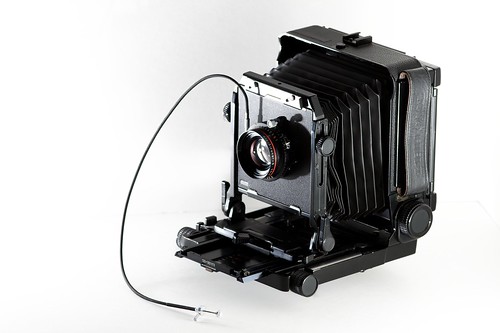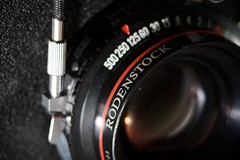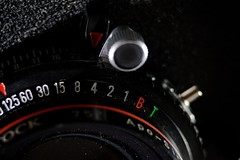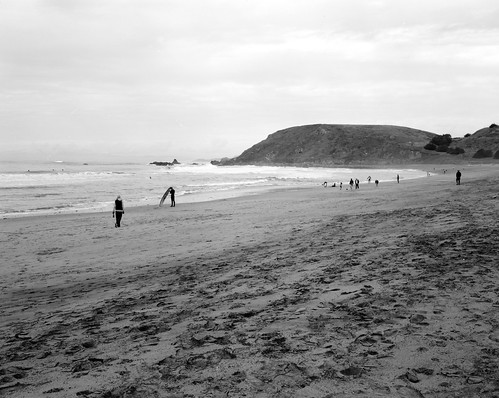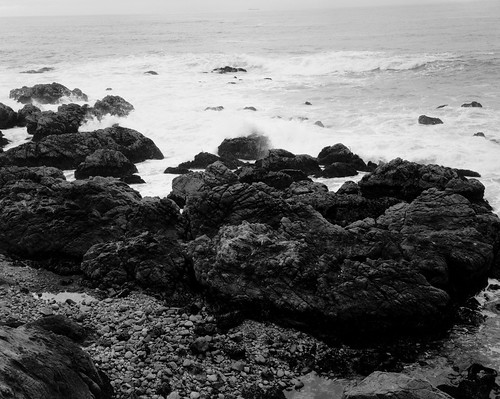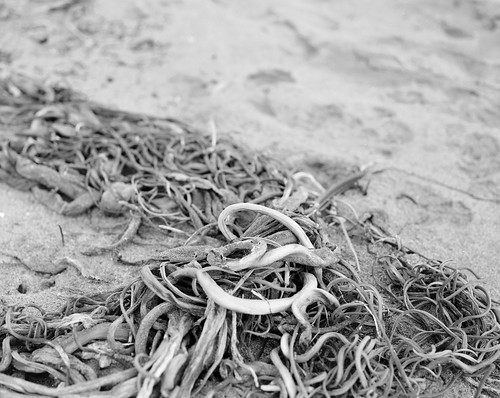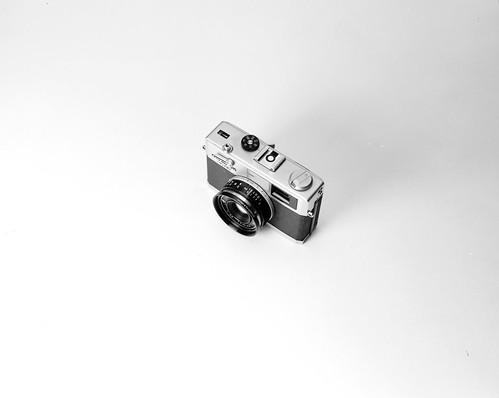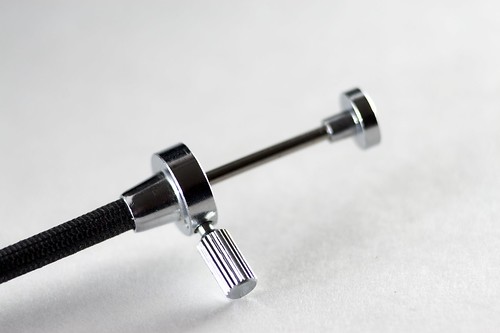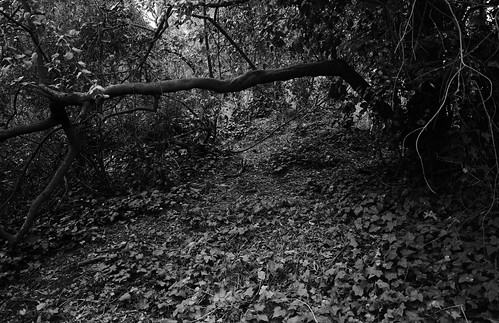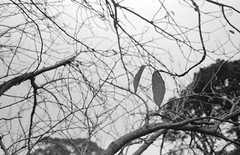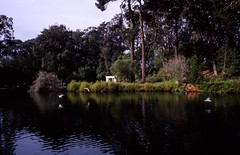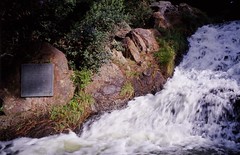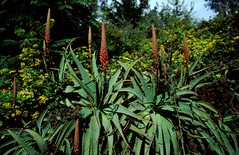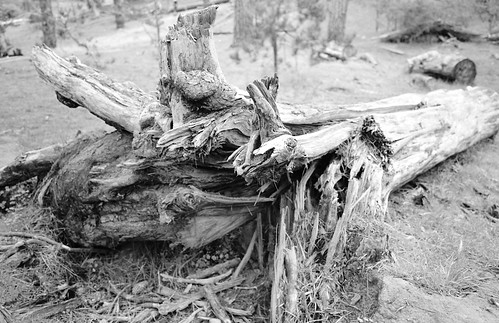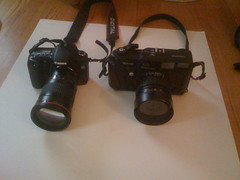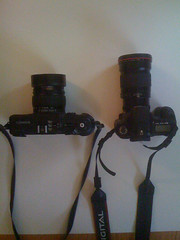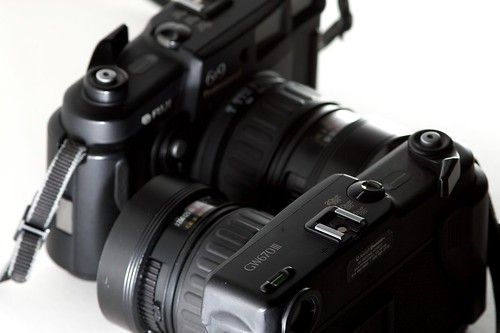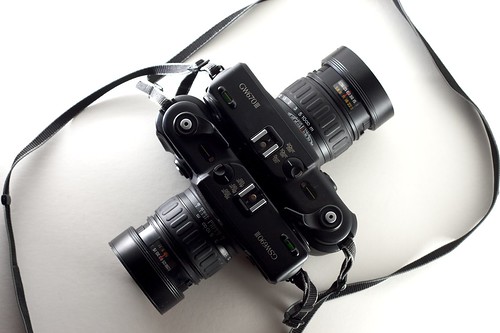Sunday, March 28, 2010
Rental Cameras: Toyo 45AII
For my final camera rental, I moved up a format size and tried a 4x5 field camera. As I mentioned earlier, I skipped the Mamiya 7 as the Fuji rangefinders gave me a good idea of how a medium format rangefinder would handle; the Mamiya would be slightly easier to use, with an integrated meter, but in all other respects much the same. Instead, I rented the Toyo 45AII, a 4x5 metal field camera. Since there's not much point extensively comparing ergonomics between a 4x5 camera designed to be used on a tripod, and handheld medium format cameras, I've condensed the usual two part post into one part for this camera. Also, there are no size comparison photos; while the Toyo is a fairly compact field camera, it still requires a tripod.
When using it on a tripod, the Toyo is very easy to use; all movements are easy to find, lock and unlock, and use. The back rotates, making vertical shots easy. Typically for most field cameras, the bellows extension tops out at about 300mm, which is fine for the intended applications, and enough for 1:1 magnification with a 150mm lens.
The lens I rented with it was a Rodenstock Apo-Sironar-S 135mm f/5.6, about which I have nothing bad to say. Small, light, and sharp. The 135mm focal length was nice, but I suspect if I were to go into 4x5 I would prefer a 90mm and a 210mm pair instead; the 135mm was slightly wide, but still close enough to a normal 150mm that I'm not quite comfortable with it.
The really interesting part of this camera though is the 4x5 negative. Sadly, the store I rented from didn't have any boxes of Ilford emulsions in stock in 4x5 size, so I had to use Kodak Tmax 400 (nothing against Kodak, I just prefer to support Ilford). Since I hadn't been having much luck with digital negatives, a 4x5 sized negative for contact printing appealed to me greatly. Scans of cyanotypes made from one of these negatives are coming shortly, but I was certainly not disappointed with them. Scanning the negatives was also very satisfying, due to all the detail in them and the incredible tonality.
To test the camera, I took it down the coast on Highway 1, down to the Point Montara lighthouse and back, stopping along the way at one of the beachs, and the Pacifica pier. The camera performed very well as a landscape camera, easy to setup and take down, and quick to use. Amazingly, I also managed to load all the film holders correctly, so all the shots came out very well.
The other test, as with the medium format cameras, was a studio style test. Due to time restrictions on returning the camera, I couldn't take any food shots, so I did a shot of one of my other cameras. Using it with the strobes was much like using the Mamiya RZ67; set the strobes for an exposure higher than what you need, due to the need to compensate for the bellows extension. The result, seen below, was excellent, showing incredible detail on the camera.
The final piece of this experience that I want to mention was the tripod the rental shop gave me with the camera; a Manfrotto/Bogen 190XDB with 804RC3 3-way head. This was an excellent combo for a lightweight 4x5 camera or any medium format camera, and I reinforced what I already knew, which is that I much prefer 3-way heads to ballheads. No matter what camera I end up with, I hope to acquire one of these tripods (probably a 190XPROB for the better center column).
Saturday, February 13, 2010
Rental Cameras: Fuji GW670 & GSW690, Part 2
This continues part 1 of my discussion of the Fuji fixed lens rangefinders, the GW670 and the GSW690. I took these two cameras on a walk through Golden Gate Park, and shot two rolls of Velvia (50 and 100), and one roll of HP5+. I took two rolls with the GSW690, since I suspected that would be my preferred camera of the two.
What I found is that these cameras have wonderful sharp lenses; certainly I can't see any difference from the RZ67 or the 503C/W shots. The 65mm in particular compares very well to the 65mm on the RZ67. Additionally, just as 6x7 doesn't seem much larger in dimensions than 6x6, but looks much larger, 6x9 looks huge compared to 6x7. Indeed, it's almost large enough to be satisfied with for contact printing.
I also enjoyed the 65mm lens on the GSW690 a lot; the wide angle view makes a very nice change from the usual fixed normal lenses. While I'm not quite as good with a wide angle as I am with a short tele or a normal, I was able to get some very successful shots with it, as long as I remembered to keep something in the foreground! Worth noting, however, is that even the 90mm lens on the GW670 will never do anything more than environmental portraits; apart from the field of view, you just can't focus close enough with a rangefinder.
In summary, either of these cameras would be a good travel camera for landscape/street/urban use; they have great lenses, large negatives, are easy to use, and easy to pack and carry. The GSW in particular would be nice for carrying around a city, with its wide angle lens. For my usage, though, it would have to be a second camera, which is just not feasible for me at this point.
Tuesday, January 5, 2010
Rental Cameras: Fuji GW670 & GSW690, Part 1
The third camera on my rental list was the Mamiya 7, but I decided that instead the Fuji rangefinders would be a representative sample of a medium format RF instead. Even used prices for the Mamiya 6 were such that I couldn't seriously consider it, so instead I went straight to the Fujis. There are 4 variations of the same basic RF, made up of all the combinations of 6x7 or 6x9 frame size with a 90mm or 65mm lens. I rented the GW670III (90mm f/3.5, 6x7) and the GSW690III (65mm f/5.6, 6x9); I would have preferred both 6x9 cameras, but the rental place I use only carries the 670 version of the GW. As before, part 1 of this discussion will focus on handling, size, weight, usage, etc, and part 2 will show results from the 3 rolls of film I exposed with these cameras.
Size and weight are the big gains from this bodystyle when compared to MF SLRs, and the comparison pics here show that fairly clearly. The pictures show a GSW690 with a 30D + 200mm f/2.8L; sadly I forgot to take the comparison pictures with the Yashica D, but the relative size should be fairly clear.
While the body size is comparable to the 30D, the lens is much smaller. And the body is really just wider and taller, not deeper. With a wide or normal prime on the DSLR, the size would be very close, with the DSLR weighing slightly less, depending on the prime used. Versus the Yashica D, this is clearly a much larger camera; however, in exchange you get a wide angle lens instead of a normal, and 6x9 film area instead of 6x6, and the camera still fits in a bag easily.
In terms of handling, the Fujis are very easy to use, with a few caveats. Shutter speed and aperture controls are on the lens barrel, and can be turned together to preserve a correct exposure with a range of settings (old-school "program mode"). Viewing and focusing is via the viewfinder, which shows framelines and an RF patch. This is the first caveat. At least on the III models I had, I found the RF patch hard to see at times. I do sometimes have the same problem on my 35RC, but given the relative prices of these cameras, I'd expect better. I believe that the older I and II models have a different RF mechanism with a different looking patch, but I don't know if it's better or worse than the III's. The second, and more minor caveat, is that the built-in lens hood on the barrel can be a little loose, and slip down over the shutter/aperture controls (it covers them when fully retracted).
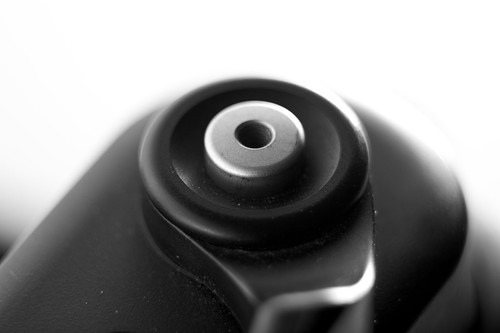
Fuji GSW690III Shutter Release; Canon 30D, Canon 200mm f/2.8L, Kenko extension tubes, Canon 430EX, LumoPro LP120
The other major downside of the fact that these cameras are rangefinders is the inability to do close up work. Even with the GW670, I would be unable to use it for food, or portraits other than environmental. To be fair, this was clear going in, and no surprise to me; these cameras work well as highly portable landscape/cityscape/etc cameras with a large negative size, and I knew that using them for anything else would be almost impossible. Still, if your needs include any sort of close up work, these would have to be a second camera, not an only/primary.
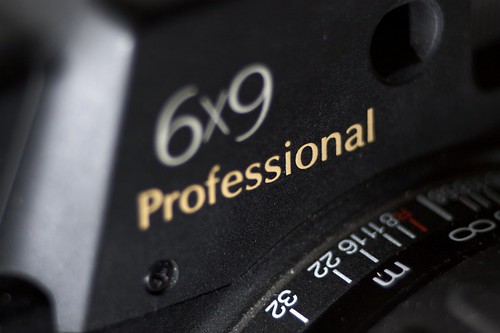
Fuji GSW690III Lettering; Canon 30D, Canon 200mm f/2.8L, Kenko extension tubes, Canon 430EX, LumoPro LP120
A major point in favor of these cameras, though, is the lens(es). While the GW has a fairly standard wide-normal 90mm lens, the GSW has a very nice 65mm lens, which on 6x9 behaves like a 28mm. If you're looking for a wide-angle fixed lens camera, this is excellent. The only minor quibble is the f/5.6, but I found that even on a gray day with 50 and 100 speed film, I was able to get easy exposures, and 400 speed would make it trivial. As far as frame sizes go, the 6x7 cameras are simply 6x9 cameras with a different film mask, advance gearing, and viewfinder framelines. Unless you really need the two extra shots a roll or hate the 3:2 aspect ratio, I'd carry the 6x9 for the extra negative size.
In their intended niche, however, these cameras are wonderful. Easy to carry, easy to use, with a nice wide-angle lens (or normal), and huge negative size. Part 2 of this discussion will look at the results from my outing in Golden Gate Park to see what results from these cameras look like.
Subscribe to:
Posts (Atom)
